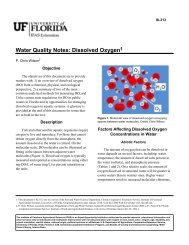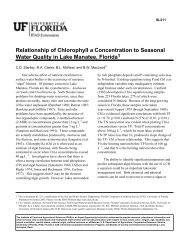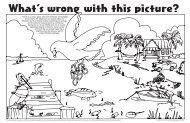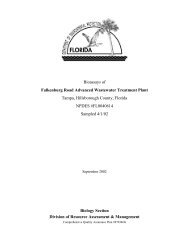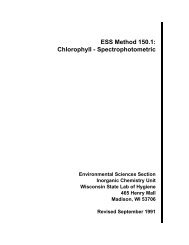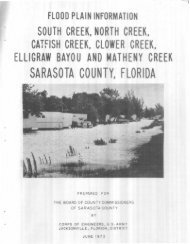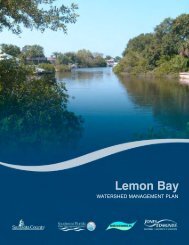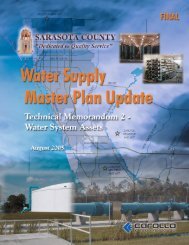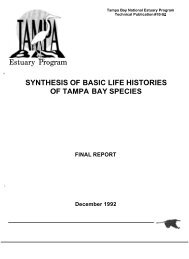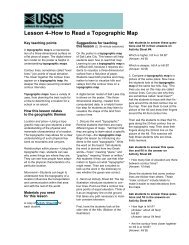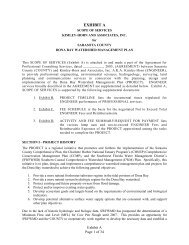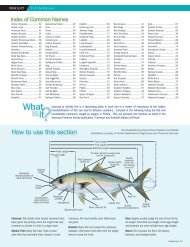Field Indicators of Hydric Soils in the United States - ITC
Field Indicators of Hydric Soils in the United States - ITC
Field Indicators of Hydric Soils in the United States - ITC
You also want an ePaper? Increase the reach of your titles
YUMPU automatically turns print PDFs into web optimized ePapers that Google loves.
CautionsSome hydric soils have morphologies that are difficultto <strong>in</strong>terpret or seem <strong>in</strong>consistent with <strong>the</strong> landscape,vegetation, or hydrology. Such soils <strong>in</strong>cludethose formed <strong>in</strong> grayish or reddish parent materials;soils that have high pH or low organic matter content;Mollisols and Vertisols; soils that have relictredoximorphic features; and disturbed soils, such ascultivated soils and filled areas.<strong>Field</strong> <strong>Indicators</strong> <strong>of</strong> <strong>Hydric</strong> <strong>Soils</strong><strong>of</strong>ten conta<strong>in</strong> no visible redoximorphic features. Inmany sites mak<strong>in</strong>g exploratory observations to ameter or more is necessary. These observationsshould be made with <strong>the</strong> <strong>in</strong>tent <strong>of</strong> document<strong>in</strong>g andunderstand<strong>in</strong>g <strong>the</strong> variability <strong>in</strong> soil properties andhydrologic relationships on <strong>the</strong> site.Depths used <strong>in</strong> <strong>the</strong> <strong>Indicators</strong> are measured from <strong>the</strong>muck or m<strong>in</strong>eral soil surface unless o<strong>the</strong>rwise <strong>in</strong>dicated.All colors refer to moist Munsell colors (fig. 3).Soil that is artificially dra<strong>in</strong>ed or protected, for <strong>in</strong>stance,by levees, is hydric if <strong>the</strong> soil <strong>in</strong> its undisturbedstate would meet <strong>the</strong> def<strong>in</strong>ition <strong>of</strong> a hydric soil. This soilshould also have at least one <strong>of</strong> <strong>the</strong> <strong>Indicators</strong>.Morphological features <strong>of</strong> hydric soils <strong>in</strong>dicate thatsaturation and anaerobic conditions have existedunder ei<strong>the</strong>r contemporary or former (recent) hydrologicregimes. Features that do not reflect contemporaryor recent hydrologic conditions <strong>of</strong> saturation andanaerobiosis are relict features. Typically, contemporaryand recent hydric soil morphologies have diffuseboundaries; relict hydric soil features have sharpboundaries. When soil morphology seems <strong>in</strong>consistentwith <strong>the</strong> landscape, vegetation, or observable hydrology,<strong>the</strong> assistance <strong>of</strong> an experienced soil or wetlandscientist may be needed to determ<strong>in</strong>e whe<strong>the</strong>r <strong>the</strong> soilis hydric.Soil colors specified <strong>in</strong> <strong>the</strong> <strong>Indicators</strong> do not havedecimal po<strong>in</strong>ts listed; however, colors do occur betweenMunsell chips. Soil colors should not berounded to qualify as meet<strong>in</strong>g an <strong>in</strong>dicator. For example,a soil matrix that has a chroma between 2 and3 should be listed as hav<strong>in</strong>g a chroma <strong>of</strong> 2+. This soilmaterial does not have a chroma 2 and would notmeet any <strong>in</strong>dicator that requires a chroma 2 or less.Particular attention should be paid to changes <strong>in</strong>topography over short distances (microtopography).Small changes <strong>in</strong> elevation may result <strong>in</strong> repetitivesequences <strong>of</strong> hydric/nonhydric soils. The del<strong>in</strong>eation<strong>of</strong> <strong>in</strong>dividual areas <strong>of</strong> hydric and nonhydric soils maybe difficult.Often <strong>the</strong> dom<strong>in</strong>ant condition (hydric/nonhydric) is<strong>the</strong> only reliable <strong>in</strong>terpretation. The shape <strong>of</strong> <strong>the</strong>local landform can greatly affect <strong>the</strong> movement <strong>of</strong>ProcedureTo document a hydric soil, first remove all loose leafmatter, needles, bark, and o<strong>the</strong>r easily identifiedplant parts to expose <strong>the</strong> surface. Dig a hole anddescribe <strong>the</strong> soil pr<strong>of</strong>ile to a depth <strong>of</strong> at least 50 cm(20 <strong>in</strong>). Us<strong>in</strong>g <strong>the</strong> completed soil description specifywhich <strong>Indicators</strong> have been matched.Deeper exam<strong>in</strong>ation <strong>of</strong> soil may be required wherefield <strong>in</strong>dicators are not easily seen with<strong>in</strong> 50 cm(20 <strong>in</strong>) <strong>of</strong> <strong>the</strong> surface. It is always recommended thatsoils be excavated and described as deep as necessaryto make reliable <strong>in</strong>terpretations. For example,exam<strong>in</strong>ation to less than 50 cm (20 <strong>in</strong>) may suffice <strong>in</strong>soils that have a surface horizon <strong>of</strong> organic materialor mucky m<strong>in</strong>eral material because <strong>the</strong>se shalloworganic accumulations only occur <strong>in</strong> hydric soils.Conversely, depth <strong>of</strong> excavation is <strong>of</strong>ten greater than50 cm (20 <strong>in</strong>) <strong>in</strong> Mollisols because <strong>the</strong> upper horizons<strong>of</strong> <strong>the</strong>se soils mask <strong>the</strong> effect <strong>of</strong> organic material andFigure 3.Indicator F6 Redox Dark Surface. The left ismoist and <strong>the</strong> right is dry. Most commonlymoist soil colors are to be used when identify<strong>in</strong>gand del<strong>in</strong>eat<strong>in</strong>g hydric soils.(430, FIHS, Ver. 5.01, March 2003) 3



